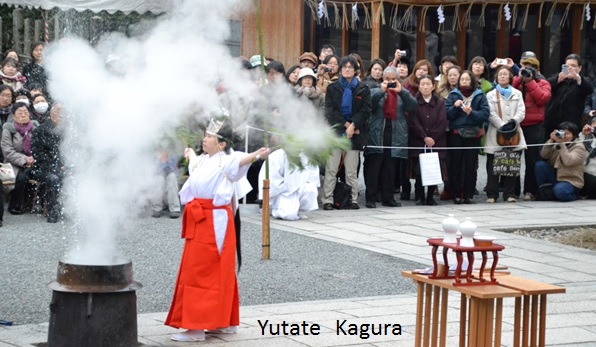Festivals
- Shrine Maiden Kagura(Admission free)
 Worshipers to Jonangu request the shrine maidens to perform a kagura, or ritual dance, to appease the deities and ask for divine protection
in the fervent hope that the deities hear their supplications. So every
day the shrine precinct is filled with the ringing of the kagura bells.
Visitors can also watch the shrine maiden’s kagura at the Kaguraden Hall’s
center stage on the following days for free.
Worshipers to Jonangu request the shrine maidens to perform a kagura, or ritual dance, to appease the deities and ask for divine protection
in the fervent hope that the deities hear their supplications. So every
day the shrine precinct is filled with the ringing of the kagura bells.
Visitors can also watch the shrine maiden’s kagura at the Kaguraden Hall’s
center stage on the following days for free.
•February 18 until around March 21: 10 a.m. (Saturdays and Sundays, 10 a.m. and 3 p.m.), Plum Branch Shrine Maiden Kagura
•May 1 until around May 8: 10 a.m. and 3 p.m., Wisteria Shrine Maiden Kagura
•July 20: 6–8:30 p.m., Summer Evening Kagura
•September 1, 9, and all Saturdays, Sundays and Public Holidays in September: 10 a.m. and 3 p.m., Chrysanthemum Shrine Maiden Kagura
- Kyokusui-no-Utage
 This elegant poetry-composition event, which was popular in the imperial
court from the Nara Period (710–794) through the Heian Period (794–1185),
is held twice annually in Jonangu’s garden. Kyokusui-no-utage was essentially
an aristocratic garden party. Seven poets (five male, two female) dressed
in Heian court attire enter the garden and are shown the day’s theme on
a piece of paper. They then take their positions by the meandering stream.
A young woman performs the Shirabyoshi-no-mai dance, and two boys fill
numerous vermilion-lacquered sake cups with sacred sake and float them
one at a time down the stream on mandarin duck-shaped vessels. With the
koto playing in the background, the poets improvise tanka poems (of 31
syllables) on paper strips. Once they have written their tanka, each poet
takes a vessel sip on the sake. When all seven poets have drunk the sake,
the boys collect the completed tanka. The seven poems are each set to a
traditional tune and dedicated to the deities. Experience the elegance
of the imperial court a millennium ago in this hour-long event.
This elegant poetry-composition event, which was popular in the imperial
court from the Nara Period (710–794) through the Heian Period (794–1185),
is held twice annually in Jonangu’s garden. Kyokusui-no-utage was essentially
an aristocratic garden party. Seven poets (five male, two female) dressed
in Heian court attire enter the garden and are shown the day’s theme on
a piece of paper. They then take their positions by the meandering stream.
A young woman performs the Shirabyoshi-no-mai dance, and two boys fill
numerous vermilion-lacquered sake cups with sacred sake and float them
one at a time down the stream on mandarin duck-shaped vessels. With the
koto playing in the background, the poets improvise tanka poems (of 31
syllables) on paper strips. Once they have written their tanka, each poet
takes a vessel sip on the sake. When all seven poets have drunk the sake,
the boys collect the completed tanka. The seven poems are each set to a
traditional tune and dedicated to the deities. Experience the elegance
of the imperial court a millennium ago in this hour-long event.
•April 29: starting at 3 p.m.
- Jonan-sai(Admission free)
 This festival, which survives from the Heian Period, once entertained retired
emperors and aristocrats. Three splendid mikoshi portable shrines, weighing about 1.5 tons, are enthusiastically carried
by around 100 men each to the cries of “hoitto, hoitto.” The first mikoshi departs the shrine at midday, with the others following at regular intervals.
The deities riding in the mikoshi tour the parish under their protection and bless the people. The return
of the mikoshi to the shrine in the evening is a grand sight, with lanterns and flaming
torches lighting the way.
This festival, which survives from the Heian Period, once entertained retired
emperors and aristocrats. Three splendid mikoshi portable shrines, weighing about 1.5 tons, are enthusiastically carried
by around 100 men each to the cries of “hoitto, hoitto.” The first mikoshi departs the shrine at midday, with the others following at regular intervals.
The deities riding in the mikoshi tour the parish under their protection and bless the people. The return
of the mikoshi to the shrine in the evening is a grand sight, with lanterns and flaming
torches lighting the way.
•October, 3rd Sunday
- Other Main Events(Admission free)
 •January 20
•January 20
Yutate Kagura ritual dance and purification ceremony
•April, 2nd Saturday through Sunday
Hoyoke Taisai(Hoyoke Festival) with performances dedicated to the deities
•June 25–30
Chi-no-wa Kuguri and Hitogata Nagashi purification rituals
English Page Top Festivals(Page of top) Precinct Garden Amulets Access